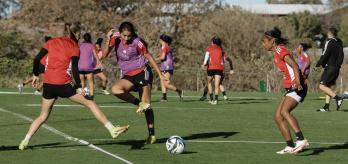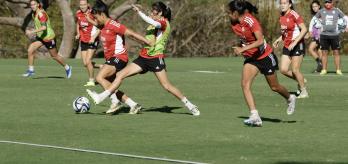Knowing when to engage and being able to channel the opposing ball carrier into less dangerous areas are crucial aspects that must be practised frequently; otherwise, defensive lines are easily broken. Defenders can give themselves a better chance by pressing receivers before they get the ball and communicating with team-mates when an opposing player leaves their zone.
In this session, the head coach of the Costa Rican women’s national team, Beni Rubido, and one of his assistants, Patricia Aguilar, deliver a series of defensive exercises. The session starts with individual defensive skills and moves into a possession game where intense pressing is required. The final three exercises showcase a variety of 11v11 games in which intense pressing and player-to-player defending are highlighted.
Session overview
Key coaching points
-
Defending players should decide whether to engage an attacker quickly or delay their movement depending on their positioning and body orientation.
-
Defending players should shepherd ball carriers to the desired side in order to make it easier to make an interception or block by maintaining a side-on, easy-to-adjust position.
-
As a unit, teams can prepare for defensive duels by squeezing up the pitch and preventing the opposition from turning or having space to pass and build momentum.
-
Players should press aggressively when required but if the player that they are closing down leaves their zone, they should communicate with a team-mate to ensure that the opponent is picked up.
-
Players must prepare to switch across and follow any opponents who have been left unmarked or who have dropped into space or moved into attack from midfield.
Part 1: Defending in 1v1 situations
This first exercise introduces players to certain individual principles to work on, specifically 1v1 defensive skills. When being dribbled at, defenders must shepherd their opponents in the direction in which they wish them to go.
-
Mark out two 50x25m areas parallel to one another.
-
Position two 5m-wide gates (marked with cones) about 10m apart in the middle of each area.
-
Split the group into 2 teams in 2 areas.
-
Mark out a starting point 20m from the (imaginary) halfway line at both ends of each area.
-
Position an equal number of players at each starting point.
-
Position a defender inside each area, 5m in front of the gates and facing the opposing players.
-
The sequence starts with 1 player dribbling towards the defender.
-
The defender must passively approach the player dribbling without attempting to steal the ball.
-
The ball carrier must decide which gate to dribble through.
-
The ball carrier then passes to a player on the other side.
-
Ball carriers become defenders and defenders join the back of the queue on the side of the area in which they were defending.
-
Defenders can now steal the ball if they have the chance.
-
Defenders should initiate the press from the centre when approaching the ball carrier and then determine where to shepherd them.
-
Defenders should approach the ball carrier with an open and side-on stance, so that it is easier to adjust their body and show them in a particular direction.
-
Attackers must try to throw the defender off balance and keep them guessing as to which gate they will go through.
-
The defensive pressure should be intensified as the exercise goes on, to match real-game scenarios.
Part 2: 4v4 plus 4 – possession transition game
The second exercise comprises a possession game and focuses on pressing in transitions. The players must react quickly to defend and press as soon as the ball is transferred to the other half.
-
Mark out a 40x20m area and split it into halves.
-
Split the group into 3 teams of 4 (oranges, blues and greens).
-
3 orange, 3 blue and 2 green players start in one half of the area.
-
1 orange and 1 blue player wait in the other half of the area.
-
Position a green player at either end of the half where the ball starts.
-
The green players are neutral.
-
The blues start in possession and combine with the greens to keep the ball inside the half that they start in.
-
The oranges must press and try to win the ball.
-
Once they win possession, they must transfer it to the other half, where their team-mate is waiting.
-
The orange team must then keep possession and the blue team must transition to become the pressing team in this half.
-
Every time a team win the ball back, they transfer possession to the other half.
-
Triggers such as poor touches and the opponent’s body shape should be identified so that the press can be timed efficiently.
-
Players should press with intensity and apply defensive principles such as shepherding opposing players in the desired direction.
-
The defending player in the opposite half must stay switched-on and be prepared to press at any moment.
Part 3: 11v11 plus 2
This exercise puts the 1v1 defensive principles into practice further in the form of a typical game. Players must press aggressively and perform player-to-player defensive actions by applying the principles.
-
Mark out a 70x50m pitch.
-
At each end of the pitch, mark out 3 gates 15m away from each other using poles.
-
Position a goalkeeper at each end to start the attack.
-
Mark out a 50x40m area in the centre of the pitch and split it into 4 squares.
-
Split the group into 2 teams of 11, with 2 neutral players.
-
Both teams must operate in a 4-4-2 formation.
-
All the players start inside the central area except for the goalkeepers.
-
The oranges start with possession and must build up play.
-
The 2 neutral players stay in the centre of the pitch to create overloads with the team in possession.
-
When a team regains possession in the opponent's half, they are encouraged to launch direct attacks, whereas if they regain possession in their own half, they must restart play with the goalkeeper.
-
To score a goal, the players must dribble the ball through any of the 3 gates.
-
Players should stay within 2m of opponents, close down passing lanes and anticipate them receiving the ball to prevent them from turning.
-
Players should follow and stay close to opponents in their zones. If an opponent moves into another zone to receive the ball, the player tracking them should communicate with a team-mate to ensure that the player is picked up.
-
If a team-mate presses the ball carrier, such as a centre-back, then covering players must step up and get close to potential receiving players.
-
Midfielders should be wary of opposing players moving from midfield into attack and should follow them to block off the run.
-
1v1 defensive principles should be applied, such as shepherding players in the direction that is the least dangerous or that makes it easiest to adjust the body to challenge for or intercept the ball.
Part 4: 11v11 attack v. defence
This exercise is an 11v11 attack v. defence scenario and implements the concepts from the previous exercises. Players must work in a structured pressing system and make defensive decisions when trying to win the ball back.
-
Use a full-size pitch with a full-size goal.
-
Position a goalkeeper at each end.
-
Split the group into 2 teams of 10.
-
The oranges should use a 4-4-2 diamond formation, while the blues should set up in a 4-1-3-2.
-
The ball starts with the blue goalkeeper.
-
The oranges should all start high up the pitch, with the defensive line on the halfway line and the attackers ready to press.
-
The blues must build up play and try to mount an attack.
-
Once the ball progresses into the final third, the orange goalkeeper must drop back into their goal.
-
The blue goalkeeper must push up into the central area as soon as their team progress the ball forward.
-
The oranges must press immediately and try to win the ball.
-
The oranges must use the attacking shape and midfield diamond to stay in between opposing players and press.
-
The defending team must aggressively press the team in possession from their goal kick and shut off passing lanes.
-
If the blues break the first line of the press, the oranges must stay high and compact, with each player within 10m of a team-mate.
-
The pressing team can force the opposing centre-backs to play the ball out wide instead of inside by staying close to opponents in central areas and following any players who drop to receive the ball.
-
If a player drops to receive the ball, the opponents should prevent them from turning.
-
As soon as possession is won in a team’s own half, they must play forwards quickly and squeeze up as a unit to condense the pitch for the opposition.
Part 5: 11v11 game
This final session applies all the principles covered in the previous exercises in a match environment. The players must press and defend within a coordinated structure.
-
Use a full-size pitch with a full-size goal.
-
Position a goalkeeper at each end.
-
Split the group into 2 teams of 10.
-
The blues should use a 4-3-3 formation, while the oranges should set-up in a 4-4-2.
-
The teams contest a standard 11v11 game.
-
Play restarts with a goal kick when a team score.
-
When either team have a goal kick, their centre-backs should drop deep to receive the ball and their full-backs should push wide.
-
Teams should build play using a defined structure and look to make typical combinations to move from defence to attack.
-
The team out of possession must press aggressively and cut off any potential passing lanes.
-
When defending, players must stay compact and within 10m of a team-mate.
-
Defending players should press in between two opponents to force them into difficult decisions, while also being able to press the chosen option quickly.















